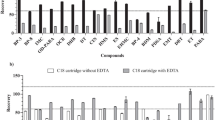Abstract
An analytical method for the determination of UV filter substances in fish tissue has been developed and validated using benzophenone-3, 3-(4-methylbenzylidene)-camphor, 2-ethylhexyl-2-cyano-3,3-diphenyl-2-propenoate and 2-ethylhexyl 3-(methoxyphenyl)-2-propenoate as target analytes. The fish fillets were homogenised and extracted by Soxhlet extraction. The extracts were run through a clean-up process including gel permeation chromatography followed by solid-phase extraction. Quantification of the compounds was performed using liquid chromatography with tandem mass spectrometric detection. Blank fish as well as spiked blank fish were analysed to validate the analytical method. The analytical method developed has the multiple advantages of enabling separation, simultaneous identification and quantification of each of the four selected compounds in a single run. Contamination of blank samples and abnormally high concentrations in spiked samples were avoided by taking extensive precautions during the fish preparation procedure. The method was validated in accordance with internationally accepted criteria, such as specificity, accuracy and repeatability. The combination of LC with tandem mass spectrometry ensures a high level of specificity. The accuracy of the method was reported as the mean recovery rate for the analytes in the sample matrix. Mean recoveries were in the range 86–108%. The precision is expressed as the relative standard deviation, and in all but one of the cases was 20% or below. The accuracy of the method allows residue analyses to be performed on biological matrices at ng/g levels. The determined limit of quantification for each analyte was 8 ng/g fish. For all spiking levels ≥8 ng/g, relative standard deviations were ≤ 20%.





Similar content being viewed by others
Abbreviations
- BP-3:
-
benzophenone-3
- GPC:
-
gel permeation chromatography
- 4-MBC:
-
3-(4-methylbenzylidene)-camphor
- OC:
-
octocrylene (2-ethylhexyl-2-cyano-3,3-diphenyl-2-propenoate)
- EHMC:
-
ethylhexyl methoxycinnamate (2-ethylhexyl 3-(methoxyphenyl)-2-propenoate)
- LOD:
-
limit of detection
- LOQ:
-
limit of quantification
References
Straub JO (2002) Concentrations of UV filter ethylhexyl methoxycinnamate in the aquatic compartment: a comparison of modelled concentrations for Swiss surface waters with empirical monitoring data. Toxicol Lett 131:29–37
Balmer M, Buser H-R, Poiger T (2002) UV filter compounds in fish from Swiss lakes, a pilot study. Technical report for the attention of the Sun Protection Industry (SPI) Consortium. Eidgenössische Forschungsanstalt für Obst-,Wein- und Gartenbau, Wädenswil
Balmer ME, Buser H-R, Mueller MD, Poiger T (2004) Occurrence of organic UV filter compounds BP-3, 4-MBC, EHMC and OC in wastewater, surface water, and fish from Swiss lakes. Buwal Project 3189.041.01.14, Eidgenössische Forschungsanstalt für Obst-,Wein- und Gartenbau, Wädenswil
Balmer ME, Buser H-R, Mueller MD, Poiger T (2005) Occurrence of some organic UV filters in wastewater, surface water, and fish from Swiss lakes. Environ Sci Technol 39(4):953–962
Poiger T, Buser H-R, Balmer ME, Bergqvist PA, Müller MD (2004) Occurrence of UV filter compounds from sunscreens in surface water: regional mass balance in two Swiss lakes. Chemosphere 55(7):951–963
Nagtegaal M, Ternes TA, Baumann W, Nagel R (1997) UV-Filtersubstanzen in Wasser und Fischen, Z. Umweltchem. Ökotox 9(2):79–86
EC (2004) SANCO/825/00 rev.7: Guidance document on residue analytical methods. European Commission Directorate General Health and Consumer Protection, European Commission, Directorate General Health and Consumer Protection, Brussels
Deutsche Forschungsgemeinschaft, Validierung der Verfahren zur Rückstandsanalyse von Pflanzenschutzmitteln (2000) Senatskommission zur Beurteilung von Stoffen in der Landwirtschaft, Mitteilung 3. Wiley VCH, Weinheim
Hänel R, Siebers J (1998) Leitlinie: Rückstandsanalysemethoden für die Überwachung. Berichte aus der Biologischen Bundesanstalt für Land- und Forstwirtschaft, Heft 43, Eigenverlag, Braunschweig
Egli H, Dassenakis M, Garelick H, Van Grieken R, Peijnenburg WJGM, Klasinc L, Kördel W, Priest N, Tavares T (2003) Minimum requirements for reporting analytical data for environment samples (IUPAC Technical Report). Pure Appl Chem 75(8):1097–1106
Hany J, Nagel R (1995) Nachweis von UV-Filtersubstanzen in Muttermilch. Deutsche Lebensmittel-Rundschau 91(11):341–345
Buser H-R, Mueller MD, Balmer ME, Poiger T, Buerge IJ (2005) Stereoisomer composition of the UV filter 4-methylbenzylidene camphor in environmental samples. Environ Sci Technol 39(9):3015–3019
BGA (1999) Amtl. Sammlung von Untersuchungsverfahren nach §35 LMB; Untersuchung von Lebensmitteln 00.00 34, November 1999. Bundesverband des deutschen Groß- und Ausßenhandels eV (BGA), Beuth Verlag, Berlin
EC (2002) INCI Inventory of Cosmetic Ingredients, Cosmetics Directive Dir 76/768/CEE Annex VII, Council Directive of 27 July 1976 (76/768/EEC). European Communities, Brussels
US EPA (2004) ECOWIN v0.99h. OPPT Risk Assessment Division, US Environmental Protection Agency, Washington, DC
Acknowledgements
We would like to acknowledge the companies Beiersdorf AG, L’OREAL, Merck KGaA, Mibelle AG Cosmetics, Procter & Gamble, Sara Lee Household & Body Care, Symrise GmbH & Co. KG, Wella Service GmbH for funding this study.
Author information
Authors and Affiliations
Corresponding author
Rights and permissions
About this article
Cite this article
Meinerling, M., Daniels, M. A validated method for the determination of traces of UV filters in fish using LC–MS/MS. Anal Bioanal Chem 386, 1465–1473 (2006). https://doi.org/10.1007/s00216-006-0706-9
Received:
Revised:
Accepted:
Published:
Issue Date:
DOI: https://doi.org/10.1007/s00216-006-0706-9




